
8 minute read
Wellbeing
Talking Dentistry
This month we’re talking restorative dentistry with Dr Andrew See who combines passion, artistic flare and extensive knowledge of dentistry to answer any questions you may have. He has advanced training in aesthetic and implant dentistry.
Advertisement
Reader’s question: “Is it true that teeth are ground down to stumps before veneers can go on?” Dr See says: Thank you for the great question, this is something that we often get asked. Believe it or not, multiple porcelain veneers is not taught at undergraduate university as they are very technique sensitive as they rely on solely bonding alone (the glue) without any mechanical retention. A lot of things therefore need to go right for their long-term success. It requires perfect preparations, perfect impressions or scans, perfect isolation for bonding and a super perfect bite. It is not easy and time consuming. Crowns on the other hand is what all clinicians are well trained at in our undergraduate studies. Crowns do involve grinding the teeth down to stumps. It is more straightforward to prepare, take an impression, provisionalise and place on the tooth. Don’t get me wrong. I do crowns often but only when clinically indicated. Such as, when there is a lack of tooth structure and/or significant pre-existing destruction from tooth wear or decay, or over root canal treated teeth. Let’s look at a case that we completed with minimal preparations for the veneers: Tim came to see us because he didn’t like that his teeth were crooked, narrow and pointy which meant he wasn’t smiling much. Tim showed us photos of his ideal smile and we collaborated to bring the design to life in a smile style that was customised to him. Tim was concerned about the health of his teeth and didn’t want to affect his natural teeth in an adverse way, but wanted to enhance his smile which affected how he felt and the way he presented himself.
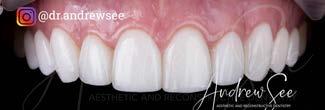
BEFORE MINIMAL TOOTH PREPARATIONS AFTER
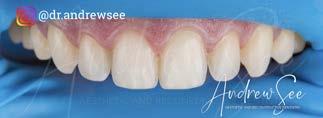
THE PROBLEMS:
• Crooked teeth • Discoloured teeth • Narrow and pointy teeth
THE SOLUTION:
• Alignment of teeth with clear aligners • Tooth whitening • 10 x porcelain veneers with minimal preparations that stayed within enamel Tim’s crooked, discoloured teeth are now addressed with beautiful, natural looking, handcrafted porcelain veneers. Advanced qualifications and experience ensured that we achieved the results that Tim wanted.
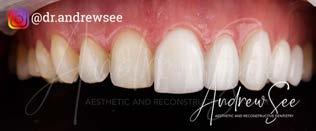
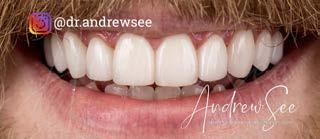
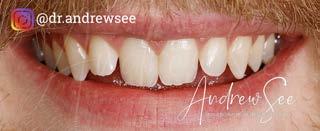
If you have any questions you have always wanted to know about aesthetic or implant dentistry write to us at info@advanceddentistrysydney.com.au

9816 4885 dr.andrewsee advanceddentistrysydney.com.au DR ANDREW SEE
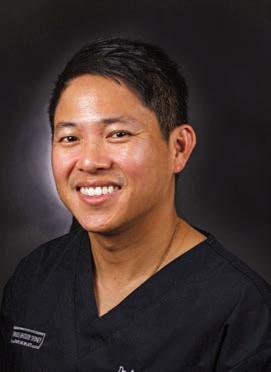
BDS Hons (Syd), FRACDS, MSc(Lond), PGDipDentImplantology, MFGDP(UK), FICOI, MFDS RCSEng
HOW ARE WE DIFFERENT?
Dr Andrew See has dedicated the last 18 years to Aesthetic Dentistry and has unique qualifications in cosmetic dentistry and rehabilitation.
This includes a 3-year Masters in Aesthetic Dentistry from the prestigious King’s College London and a Postgraduate Diploma in Dental Implantology.
Dr See completed his Fellowship by primary and secondary examinations for The Royal Australasian College of Dental Surgeons (FRACDS). FRACDS is the mark of professional achievement in dentistry and demonstrates attainment of an advanced level and skill in Dentistry.
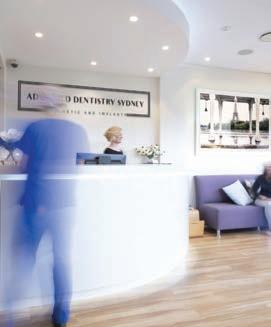
Call out to all Australian men
This month’s article is especially for you!
BY DR CARL WONG
DR CARL WONG IS A LANE COVE-BASED GP AND SITS ON THE BOARD OF SYDNEY COMMUNITY SERVICES
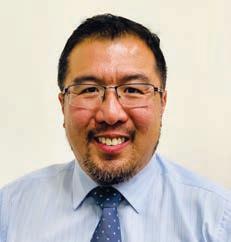
It is not uncommon at times that I will have conversations with my male patients that begin with: ‘Doc, I’m here today because my wife was concerned about this skin spot on my back and told me to have it checked out’ or ‘I’ve been told by my missus to have a health check-up’. Of course, I am being a bit cheeky and stereotypical with these above statements. But as a doctor I am very grateful for any type of prompting if it means that Australian men seek medical help and take their health more seriously. Studies have shown that compared to Australian women, Australian men visit the doctor less frequently, and only attend when the illness is in its later stages. Why is all this important? Because the figures are alarming. On average, Australian men will have four years less life expectancy than Australian females. The number of male deaths are higher than female deaths in every age group except for the over-65 years old age group, likely due to
so many men dying before this retirement age. Men are more likely to get sick from serious health problems and die in greater numbers in almost every health condition that is non-gender-related. Higher risk of male death and serious illness is especially in Aboriginal and Torres Strait Islanders, those who live in rural and remote areas, overseas On average, Australian men will have four years less life expectancy than Australian females migrants, those who are social disadvantaged, and non-heterosexual men. I can still recall my time as a junior doctor working in rural hospitals; male farmers would come into the emergency department, with quite serious physical limb injuries which they often have had for weeks already and be nonchalant as to what all the concern was about! Looking further, Australian Institute of Health and Welfare (2018) data shows that 74% of men are overweight or obese, compared to 59% of women. Obesity is a significant risk factor in developing conditions such as Type 2 diabetes, high blood pressure, heart disease, and obstructive sleep apnoea.

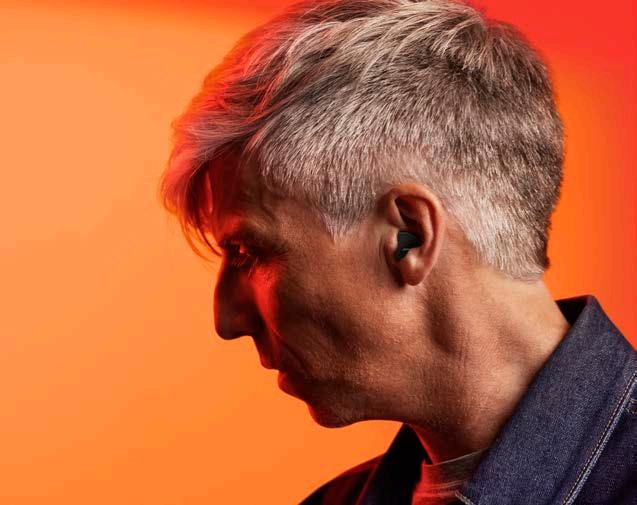
But perhaps the most tragic statistic, is that men account for 75% of suicides in Australia, and it is the leading cause of death in men under the age of 54 years, according to Australian Bureau of Statistics (2016). So what are the reasons for why women are more healthier than men? The answers are numerous, complex and not entirely understood. Men typically have a functional view of their bodies and health and therefore may ignore milder symptoms until they become severe enough to impact their daily life. This leads to longer term and higher burden of disease due to delayed diagnoses. Some may also feel embarrassed, and not wanting to appear weak by seeking professional help, particularly if related to mental health. Thankfully due to more public awareness, depression in men is not as stigmatised and seeking help is becoming more normalised compared to the past. Men are more likely to be employed full-time and therefore have less opportunity to visit a doctor. They are traditionally employed more in occupations with a higher risk of injury, such as transport, construction and mining. Some men are more comfortable in seeing only a male health practitioner particularly if their issue is sexual or genital-related, and thereby limiting their access if more female doctors were only available. The greater expenditure on, and greater access to services for, women’s health compared to men’s health may also play a part. Prostate cancer is the common cancer in men yet receives far less funding compared to other cancers. This translates to reduced promotional awareness, especially when compared to the successful breast cancer awareness program. Men do not engage in healthy diet and lifestyle modifications as well as women. They are twice as more likely than women to drink above the recommended alcohol consumption guidelines. Approximately one in four men are drinking at levels that will lead to alcohol-related disease. At all ages, men have been shown to consume higher calorie items and less fruit and vegetables than women. Men also engage in more risk-taking behaviours, being twice as likely to die in a motor vehicle accident and also have higher rates of substance and recreational drug abuse. As we can see, optimising men’s health has its challenges to navigate. More needs to be done in understanding and overcoming many of the health barriers that men face. Focussing on these issues are certainly not just a storm in a teacup.

Balance issues
Ann Jill Kirsty Good balance is one of those things we can easily take for granted when we are young. We tend to notice our balance isn’t quite as good in middle age and then progressively our reduced balance presents as us starting to avoid activities where our balance is challenged. This can be choosing to avoid walking on uneven surfaces and eventually using rails or sticks to help our stability. Balance control is directly related to muscle strength. Loss of muscle strength is called sarcopenia and is related to frailty. As we become weaker and lose our balance control it gets tempting to further reduce activity to be ‘safe’ and so we become weaker. At Burns Bay Physiotherapy we understand the importance of maintaining balance for our general health, wellbeing, and ability to do activities of daily living. We also understand the role of good muscle strength and control in reducing hip, back, knee and other pains. Plus, the linkages between these pains, balance, and activities of daily living. We can help keep you feeling physically strong and capable, so you can confidently enjoy the activities that make you happy whatever your age.
BURNS BAY PHYSIOTHERAPY
161 Burns Bay Rd, Lane Cove P: 9427 8333 E: info@burnsbayphysiotherapy.com.au









